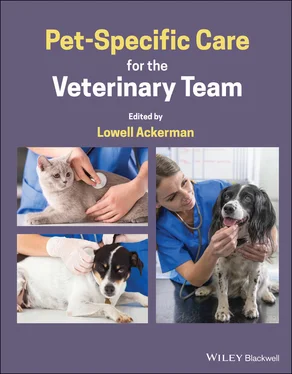Oncogenes are genes that when mutated, or expressed at high levels, cause normal cells to transition into cancer cells. The process is typically helped along by the effects of environmental carcinogens, viruses, and other stressors. In contradistinction to oncogenes, tumor suppressor genes, or antioncogenes as they are sometimes called, protect normal cells from transitioning into cancerous ones. A mutation in these genes can cause a loss of or reduction in this protective function.
3.3.8 Genetics and Behavior
Similar to cancer, little doubt exists that genetics plays a key role in predicting behaviors, and yet we are very early in the process of characterizing the process. Behaviors such as herding and retrieving are firmly entrenched in some breeds, and we are getting closer to understanding the genetic bases for these traits. In addition, it appears that dogs have evolved a social–cognitive specialization that allows them unusual skill in cooperating and communicating with humans [4]. In fact, dogs and humans accept each other into a mutual social structure, which appears to have been the result of genetic selection. Behavioral traits do have a genetic basis, and a high degree of genetic correlation between traits is often found.
Some developments have occurred in identifying quantitative trait loci (QTLs) important in some behavioral conditions, but much more is to be learned in years to come. Because behaviors are often conserved within breed groups, individual qualities (e.g., retrieving ability) can often be achieved by the appropriate selection of specific breeds, especially if representative family members can be observed. For mixed‐breed dogs, a rough approximation might be accomplished by discerning which breeds primarily contributed to an individual animal through commercially available genetic breed profiles.
 TAKE‐AWAYS
TAKE‐AWAYS
Genes don't cause diseases, but they may code for defective proteins that are associated with disease states.
Most traits are considered dominant or recessive, but that classification is not absolute in most cases.
DNA testing can be used to identify risk, but may not be absolute in predictions of clinical disease due to the properties of penetrance and expressivity.
While some diseases may be caused by a defect attributed to variants in a single gene pair, the majority of diseases are caused by an interaction of multiple genes together with environmental factors.
Genetic diseases can be attributable to more than just variants in nuclear or mitochondrial DNA; the epigenome appears to also play a significant role in disease manifestations.
 MISCELLANEOUS
MISCELLANEOUS
Abbreviation
DNADeoxyribonucleic acid
1 1 Swanson, K.S. (2006). Nutrient–gene interactions and their role in complex diseases in dogs. J. Am. Vet. Med. Assoc. 228 (10): 1513–1520.
2 2 Giger, U., Sargan, D.R., and McNiel, E.A. (2006). Breed‐specific hereditary diseases and genetic screening. In: The Dog and its Genome (eds. E.A. Ostrander, U. Giger and K. Lindeblad‐Toh), 249–289. New York: Cold Spring Harbor Laboratory Press.
3 3 Knapp, D.W., Glickman, N.W., DeNicola, D.B. et al. (2000). Naturally‐occurring canine transitional cell carcinoma of the urinary bladder: a relevant model of human invasive bladder cancer. Urol. Oncol. 5: 47–59.
4 4 Hare, B. and Tomasello, M. (2006). Behavioral genetics of dog cognition: human‐like social skills in dogs are heritable and derived. In: The Dog and its Genome (eds. E.A. Ostrander, U. Giger and K. Lindblad‐Toh), 497–514. New York: Cold Spring Harbor Laboratory Press.
1 Ackerman, L. (2011). The Genetic Connection. Lakewood, CO: AAHA Press.
2 Ackerman, L. (2019). The skinny on genes – what you should know about genetic testing. AAHA Trends 35 (6): 39–42.
3 Ackerman, L. (2020). Proactive Pet Parenting: Anticipating pet health problems before they happen. Problem Free Publishing.
4 Karlsson, E.K., Baranowska, I., Wade, C.M. et al. (2007). Efficient mapping of mendelian traits in dogs through genome‐wide association. Nat. Genet. 39: 1321–1328.
5 Modiano, J.F., Breen, M., Burnett, R.C. et al. (2005). Distinct B‐cell and T‐cell lymphoproliferative disease prevalence among dog breeds indicates heritable risk. Cancer Res. 65: 5654–5661.
3.4 Predicting and Eliminating Disease Traits
Lowell Ackerman, DVM, DACVD, MBA, MPA, CVA, MRCVS
Global Consultant, Author, and Lecturer, MA, USA
 BASICS
BASICS
3.4.1 Summary
To be able to appropriately screen pets for disease traits, it is first critical to be able to ascertain their risk of developing problems, and then intervene at the earliest possible opportunity. This is best accomplished with a combination of genotypic and phenotypic screening.
Allele:A variant or alternative form of a gene, found at the same location on a chromosome, and which can result in different observable traits.
Dominant:Heritable characteristics, traits, or diseases that are expressed when inherited even from one parent.
Genetics:The study of genes and how traits or conditions are passed from one generation to the next.
Genome:The complete set of genes for an animal.
Genomics:The study of the entire genome, and its combined influence on complex diseases and the impact of environmental factors such as diet, exercise, medications, and toxins on genes.
Genotype: An individual's genetic constitution.
Heterozygotev An individual with two different alleles for a given gene.
Homozygote:An individual with two identical alleles for a given gene.
Locus:A fixed position on a chromosome for a gene or marker.
Nutrigenomics:The interaction of genetics and nutrition and the role the two play in the prevention and treatment of disease.
Odds Ratio:The ratio of the odds of an event in a select group (e.g., breed) to the odds of an event in a control group.
Phene:A trait or characteristic that is genetically determined.
Phenotype:Observable characteristics or traits that result from the interaction of genotype with the environment.
Recessive:Heritable characteristics, traits, or diseases that are expressed only when inherited from both parents.
Relative Risk:The ratio of the probability of a phene, condition, or trait occurring in a specific group (e.g., breed), compared to the probability of it happening in a control group.
 MAIN CONCEPTS
MAIN CONCEPTS
3.4.3 Risk Factors
Pet‐specific care is all about managing risks. All animals have certain risks that pertain to their individual circumstances (see 1.1Overview of Pet‐Specific Care). By acknowledging and prioritizing risks, we can craft meaningful personalized care plans for our patients (see 1.3Personalized Care Plans).
Читать дальше

 TAKE‐AWAYS
TAKE‐AWAYS MISCELLANEOUS
MISCELLANEOUS BASICS
BASICS MAIN CONCEPTS
MAIN CONCEPTS










